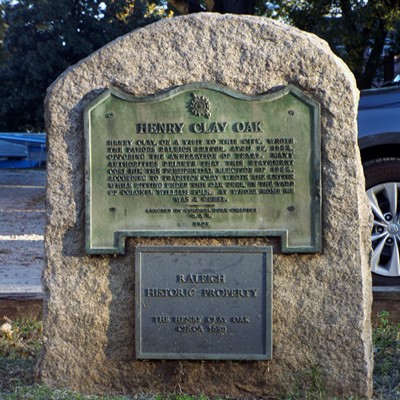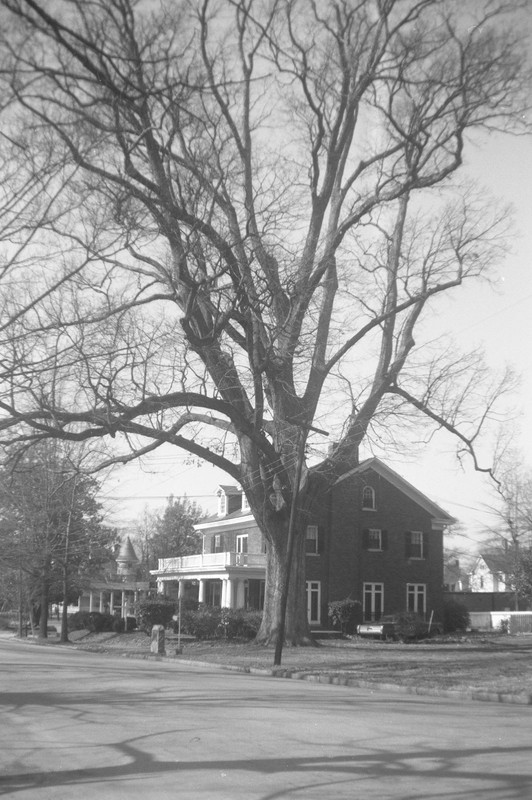Henry Clay Oak Marker
Introduction
Text-to-speech Audio
Images
Marker commemorating the Henry Clay Oak.

The Henry Clay Oak in 1967.

Backstory and Context
Text-to-speech Audio
Henry Clay was born in Virginia on April 12, 1777. After starting his law practice in Lexington, Kentucky, Clay was elected to elected to the Kentucky House of Representatives in 1803. He continued to serve as a Congressmen (at times in the Senate and at times in the House) until 1811. From that year until 1825, Clay served alternatively as a U.S. Representative and as Speaker of the House. When the War of 1812 broke out, Clay became a member of the anti-British War Hawks group in Congress. The first major act of compromise in his career was the negotiations that ended the war in 1815. He was on the path to earning himself the nickname the “Great Compromiser.”
In 1820, Clay proposed the Missouri Compromise. At the time, there were eleven slave states and eleven free states in the U.S. If Missouri were to be admitted to the Union as a slave state, the equilibrium in the Senate would be thrown off, so the free Northern states opposed it. Then, when Maine applied for statehood as a free state, the pro-slavery Southern states planned not to approve it. Instead, Clay suggested that Missouri join the United States as a slave state, and Main as a free state, preserving the balance. The compromise also put into place the Missouri Compromise line, which separated territories that would become free states if they joined the U.S. and those that would become slave states.
Henry Clay first ran for president in 1824, but the election ended with none of the five candidates earning enough Electoral College votes to win. Clay then threw his support behind John Quincy Adams, who won. Though this move was considered controversial in Clay’s home state of Kentucky, it earned him the role of Secretary of State from 1825 to 1829. During this time, Clay worked on twelve commercial treaties, more than any Secretary of State before him. Three years after his tenor as Secretary of State, Clay ran for president again. This time, he was up against President Andrew Jackson. After losing the election, he returned to the Senate, where he remained until 1842.
One last attempt to claim the presidency came in 1844, the same year he penned the “Raleigh Letter.” Clay went back to the Senate in 1849 and continued in his work until 1852. In the meantime, he laid the groundwork for another famous compromise, the Compromise of 1850, which admitted California into the Union as a free state and allowed New Mexico and Utah to vote on whether they would permit slavery. It also gave New Mexico some of Texas’s land in exchange for ten million dollars from the federal government. The Great Compromiser died from tuberculosis just two years later in 1852.
Cite This Entry
Brammer, Emily. "Henry Clay Oak Marker." Clio: Your Guide to History. February 18, 2019. Accessed April 15, 2025. https://theclio.com/tour/575/2
Sources
Henry Clay. Ohio History Central. Accessed February 18, 2019. http://www.ohiohistorycentral.org/w/Henry_Clay.
Biographies of the Secretaries of State: Henry Clay (1777–1852). Office of the Historian. Accessed February 18, 2019. https://history.state.gov/departmenthistory/people/clay-henry.
The Associated Press. "Raliegh to lose old oak tree." The Dispatch(Raleigh)September 25, 1991. , Community Calendar sec. Via Google Books.
Henry Clay Oak, Raleigh. Doc South. Accessed February 18, 2019. https://docsouth.unc.edu/commland/monument/406/. Photo source.
State Archives of North Carolina. Henry Clay Oak, Raleigh, NC. Flickr. February 09, 2018. Accessed February 18, 2019. https://www.flickr.com/photos/north-carolina-state-archives/40137350372. Photo source.

